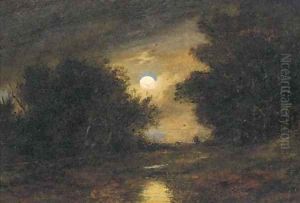John Burney Crome Paintings
John Burney Crome, born in 1794 in Norwich, England, was a distinguished British painter, emerging from a lineage deeply embedded in the artistic landscape of the 18th and 19th centuries. He was the son of John Crome, also known as Old Crome, who was one of the founders of the Norwich School of painters, a unique collective that was among the first provincial art movements in Britain. Growing up in this environment, John Burney Crome was naturally inclined towards painting from a young age, developing a style that, while reflective of his father's influence, carved out its own niche within the British art scene.
His oeuvre primarily consists of landscapes, a genre that his father had mastered and which the Norwich School was renowned for, characterized by a keen observation of nature and a delicate handling of light and shadow. However, John Burney Crome brought his own perspective to this genre, integrating more Romantic elements into his work, which was in line with the broader shifts in European art at the time. His landscapes often depicted the English countryside, imbued with a sense of moodiness and atmospheric effects that suggested an emotional depth beyond mere pictorial representation.
Despite living in the shadow of his father's substantial legacy, John Burney Crome managed to achieve recognition in his own right. He exhibited at the British Institution, the Royal Academy, and the Society of British Artists, venues that were central to the art world of his era. His works were appreciated for their technical skill and the emotional resonance they evoked, contributing to the evolving narrative of British landscape painting.
John Burney Crome's career, however, was not without its challenges. The early 19th century was a period of significant change in the art world, with the rise of new aesthetic ideals and the increasing influence of the Royal Academy, which often dictated artistic tastes and trends. Navigating this landscape required adaptability and resilience, qualities that Crome demonstrated through his evolving style and thematic exploration.
He died in 1842, leaving behind a body of work that, though not as widely recognized as that of his father, played a significant role in the continuation and development of the Norwich School's legacy. His paintings, cherished for their lyrical beauty and atmospheric depth, continue to be studied and admired for their contribution to the canon of British landscape art. John Burney Crome���s legacy is a testament to the enduring allure of the natural world and its capacity to inspire art that speaks across generations.
